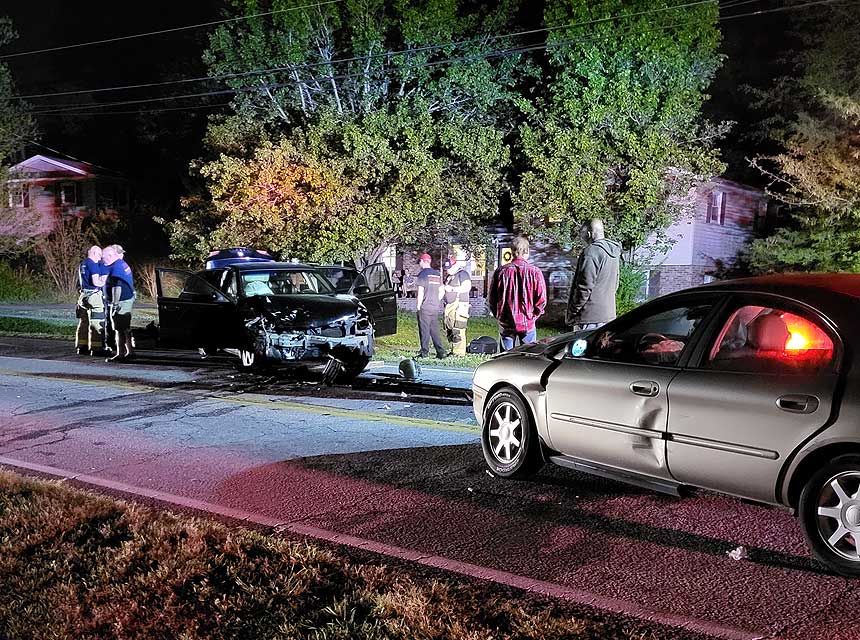
Photo by author
There are many sides to vehicle extrication response and all the tactics that go with it. This article aims to look at one basic aspect firefighters must consider on vehicle extrication calls.
Vehicle extrication calls all begin the same—by being dispatched out to the situation by the 911 operator or dispatch center. Once the call comes in, the vehicle extrication size-up begins. Once on scene, the auto ex 360 commences. Not every responding member will conduct this, but every firefighter should be able to and may have to depending upon the response model and who arrives on scene first. Doing the auto ex 360 provides the responding team a plethora of information that may affect the extrication operation.
What items need to be identified or picked up when doing the auto ex 360?
The number of vehicles involved will be one item to pick up on and note. Even though dispatch information may relay information regarding the incident, they are only going off what they are being told by the caller(s). Once on scene, it is paramount to determine the number of vehicles involved so that proper and adequate resources can be requested to assist.
The position of the vehicles will also be important to note. Wow the vehicles end up after the collision will dictate the rescue operations and the number of personnel and equipment needed for the operation. Access points to the vehicles and related tactics can also be identified during the 360.
Along with the position of the vehicles consider the number of people involved. This is part of the accountability of all on scene, including those involved in the collision. Once a number can be established, appropriate resources can be deployed to assist as needed based on the extent and nature of the injuries.
Having the established a count of who is involved, we want to note the location of the people on the scene. Some of them may be outside of their vehicles walking around while others may be still inside. Depending upon the extent of the collision, all the people may be still trapped inside their vehicles. Knowing the location helps to direct the help needed.
The damage of the vehicle is going to be self-evident based upon the collision. Depending on what has occurred, the damage will either be severe or minimal. Severe damage will indicate higher speed impacts and will also require more attention to stabilizing and removing the patients from the vehicle. The damage of the vehicle can be located on any part and can indicate how the collision occurred. This will give an idea of how best to approach the rescue operation based upon the type of collision.
All modern vehicles on the road are will be equipped with airbags or other supplemental restraint systems. These devices will deploy depending upon the type of collision and deceleration of the vehicles. Deployed airbags may indicate severe injury for the occupant(s). Sometimes when all the airbag systems deploy in the vehicle, such as the curtain systems by the windows, it will block the view inside the vehicle when doing the 360. These will need to be pushed aside so that an accurate 360 can be completed on the inside of the vehicle as well.
Many vehicle collisions will cause the fluids from the vehicle to leak out and be spilled on the ground. Many fluids are present in each vehicle, and they are going to be a hazard to rescue efforts if not dealt with. Identifying the types of fluids and where they are leaking/moving to will direct efforts to mitigate this hazard. Not all vehicles will have fluids because some vehicles are completely electric – which leads into identifying the type of vehicle(s) that are involved.
Along the roadways will be utility services. These services sometimes get involved in the vehicle collisions and become a hazard to the operation. Downed electrical wires are going to be the most hazardous of the utilities due to the unknown nature of knowing if the wires are live or not. Always treat them as live no matter what to be on the safe side until we are told by utility companies that they have been de-energized. As the 360 is conducted, note the types of utilities and where they are in relation to the incident; this is going to help with deciding how to approach the situation and deal with it.
Identifying any fire is going to be paramount. Any fire present at a vehicle collision will only cause more injury to the occupants who may be still inside the vehicle as well as the responders working to fix the problem. Getting a charged hoseline in place will be quickly needed to extinguish any fire so that extrication operations can begin. These items listed are just the basics of what is picked up on when doing a 360 around the incident scene. Training for this can be easily done by using video footage from social media and practicing a 360 or size-up based upon what is viewed and seen.

Mark van der Feyst has been in the fire service since 1999 and is a firefighter with the Fort Gratiot (MI) Fire Department. He is an international instructor teaching in Canada, the United States, and India, and at FDIC. He is also the lead author of Residential Fire Rescue (Fire Engineering Books & Video). He can be contacted at Mark@FireStarTraining.com.

